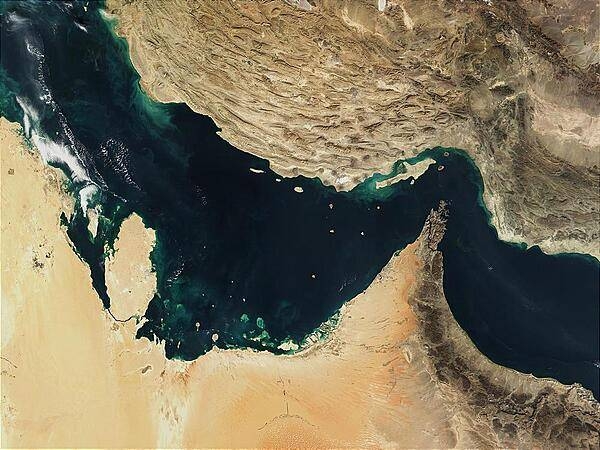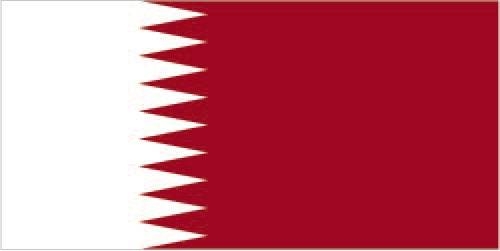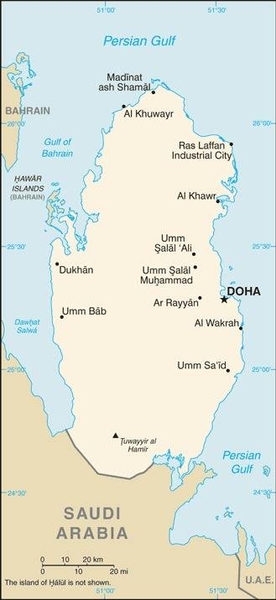Introduction
Background
Ruled by the Al Thani family since the mid-1800s, Qatar within the last 60 years transformed itself from a poor British protectorate noted mainly for pearling into an independent state with significant oil and natural gas revenues. Former Amir HAMAD bin Khalifa Al Thani, who overthrew his father in a bloodless coup in 1995, ushered in wide-sweeping political and media reforms, unprecedented economic investment, and a growing Qatari regional leadership role, in part through the creation of the pan-Arab satellite news network Al-Jazeera and Qatar's mediation of some regional conflicts. In the 2000s, Qatar resolved its longstanding border disputes with both Bahrain and Saudi Arabia and by 2007 had attained the highest per capita income in the world. Qatar did not experience domestic unrest or violence like that seen in other Near Eastern and North African countries in 2011, due in part to its immense wealth and patronage network. In mid-2013, HAMAD peacefully abdicated, transferring power to his son, the current Amir TAMIM bin Hamad. TAMIM is popular with the Qatari public, for his role in shepherding the country through an economic embargo by some other regional countries, for his efforts to improve the country's healthcare and education systems, and for his expansion of the country's infrastructure in anticipation of Doha's hosting of the 2022 FIFA Men’s World Cup.
Following the outbreak of regional unrest in 2011, Doha prided itself on its support for many popular revolutions, particularly in Libya and Syria. This stance was to the detriment of Qatar’s relations with Bahrain, Egypt, Saudi Arabia, and the United Arab Emirates (UAE), which temporarily recalled their respective ambassadors from Doha in March 2014. TAMIM later oversaw a warming of Qatar’s relations with Bahrain, Egypt, Saudi Arabia, and the UAE in November 2014 following Kuwaiti mediation and signing of the Riyadh Agreement. This reconciliation, however, was short-lived. In June 2017, Bahrain, Egypt, Saudi Arabia, and the UAE (the "Quartet") cut diplomatic and economic ties with Qatar in response to alleged violations of the agreement, among other complaints. They restored ties in January 2021 after signing a declaration at the Gulf Cooperation Council Summit in Al Ula, Saudi Arabia.
Visit the Definitions and Notes page to view a description of each topic.
Geography
Location
Middle East, peninsula bordering the Persian Gulf and Saudi Arabia
Geographic coordinates
25 30 N, 51 15 E
Map references
Middle East
Area - comparative
almost twice the size of Delaware; slightly smaller than Connecticut
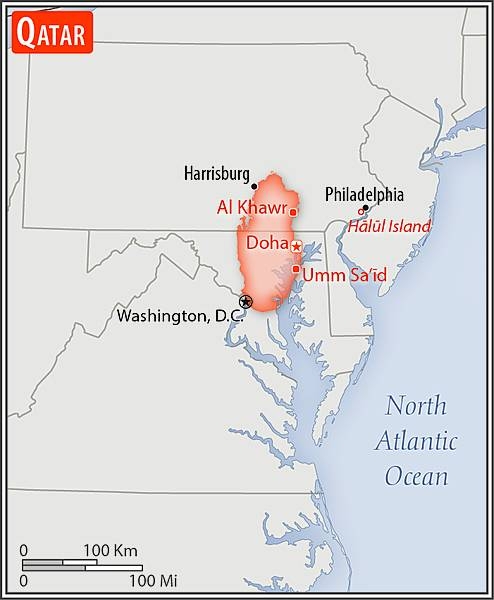
Land boundaries
total: 87 km
border countries (1): Saudi Arabia 87 km
Coastline
563 km
Maritime claims
territorial sea: 12 nm
contiguous zone: 24 nm
exclusive economic zone: as determined by bilateral agreements or the median line
Climate
arid; mild, pleasant winters; very hot, humid summers
Terrain
mostly flat and barren desert
Elevation
highest point: Tuwayyir al Hamir 103 m
lowest point: Persian Gulf 0 m
mean elevation: 28 m
Natural resources
petroleum, fish, natural gas
Land use
agricultural land: 5.6% (2018 est.)
arable land: 1.1% (2018 est.)
permanent crops: 0.2% (2018 est.)
permanent pasture: 4.3% (2018 est.)
forest: 0% (2018 est.)
other: 94.4% (2018 est.)
Irrigated land
130 sq km (2020)
Major aquifers
Arabian Aquifer System
Population distribution
most of the population is clustered in or around the capital of Doha on the eastern side of the peninsula
Natural hazards
haze, dust storms, sandstorms common
Geography - note
the peninsula occupies a strategic location in the central Persian Gulf near major petroleum deposits
People and Society
Nationality
noun: Qatari(s)
adjective: Qatari
Ethnic groups
non-Qatari 88.4%, Qatari 11.6% (2015 est.)
Languages
Arabic (official), English commonly used as a second language
major-language sample(s):
كتاب حقائق العالم، المصدر الذي لا يمكن الاستغناء عنه للمعلومات الأساسية (Arabic)
The World Factbook, the indispensable source for basic information.
Religions
Muslim 65.2%, Christian 13.7%, Hindu 15.9%, Buddhist 3.8%, folk religion <0.1%, Jewish <0.1%, other <1%, unaffiliated <1% (2020 est.)
Age structure
0-14 years: 12.84% (male 158,702/female 155,211)
15-24 years: 11.78% (male 203,703/female 84,323)
25-54 years: 70.66% (male 1,439,364/female 287,575)
55-64 years: 3.53% (male 66,561/female 19,600)
65 years and over: 1.19% (male 19,067/female 10,068) (2020 est.)
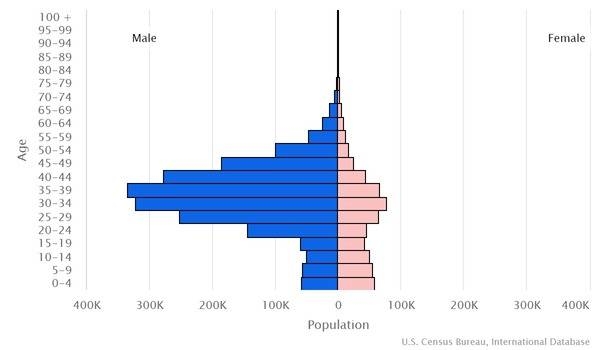
Dependency ratios
total dependency ratio: 20.7
youth dependency ratio: 16.1
elderly dependency ratio: 2
potential support ratio: 50.1 (2021 est.)
Median age
total: 33.7 years
male: 35 years
female: 28.2 years (2020 est.)
Population distribution
most of the population is clustered in or around the capital of Doha on the eastern side of the peninsula
Urbanization
urban population: 99.4% of total population (2023)
rate of urbanization: 1.66% annual rate of change (2020-25 est.)
Major urban areas - population
798,000 Ar-Rayyan, 658,000 DOHA (capital) (2023)
Sex ratio
at birth: 1.02 male(s)/female
0-14 years: 1.02 male(s)/female
15-24 years: 2.26 male(s)/female
25-54 years: 5.45 male(s)/female
55-64 years: 3.42 male(s)/female
65 years and over: 1.13 male(s)/female
total population: 3.36 male(s)/female (2022 est.)
Maternal mortality ratio
9 deaths/100,000 live births (2017 est.)
country comparison to the world: 149Infant mortality rate
total: 6.62 deaths/1,000 live births
male: 7.25 deaths/1,000 live births
female: 5.96 deaths/1,000 live births (2022 est.)
Life expectancy at birth
total population: 79.81 years
male: 77.7 years
female: 81.96 years (2022 est.)
Contraceptive prevalence rate
37.5% (2012)
Drinking water source
improved: urban: NA
rural: NA
total: 99.6% of population
unimproved: urban: NA
rural: NA
total: 0.4% of population (2020 est.)
Current health expenditure
2.9% of GDP (2019)
Physicians density
2.49 physicians/1,000 population (2018)
Hospital bed density
1.3 beds/1,000 population (2017)
Sanitation facility access
improved: urban: NA
rural: NA
total: 100% of population
unimproved: urban: NA
rural: NA
total: 0% of population (2020 est.)
Alcohol consumption per capita
total: 0.96 liters of pure alcohol (2019 est.)
beer: 0.29 liters of pure alcohol (2019 est.)
wine: 0.07 liters of pure alcohol (2019 est.)
spirits: 0.59 liters of pure alcohol (2019 est.)
other alcohols: 0.01 liters of pure alcohol (2019 est.)
Tobacco use
total: 11.8% (2020 est.)
male: 21.7% (2020 est.)
female: 1.9% (2020 est.)
Literacy
definition: age 15 and over can read and write
total population: 93.5%
male: 92.4%
female: 94.7% (2017)
School life expectancy (primary to tertiary education)
total: 13 years
male: 12 years
female: 15 years (2021)
Youth unemployment rate (ages 15-24)
total: 0.5%
male: 0.2%
female: 1.7% (2020 est.)
Environment
Environment - current issues
air, land, and water pollution are significant environmental issues; limited natural freshwater resources are increasing dependence on large-scale desalination facilities; other issues include conservation of oil supplies and preservation of the natural wildlife heritage
Environment - international agreements
party to: Biodiversity, Climate Change, Climate Change-Kyoto Protocol, Comprehensive Nuclear Test Ban, Desertification, Endangered Species, Hazardous Wastes, Law of the Sea, Ozone Layer Protection, Ship Pollution
signed, but not ratified: none of the selected agreements
Air pollutants
particulate matter emissions: 90.35 micrograms per cubic meter (2016 est.)
carbon dioxide emissions: 103.26 megatons (2016 est.)
methane emissions: 8.34 megatons (2020 est.)
Climate
arid; mild, pleasant winters; very hot, humid summers
Land use
agricultural land: 5.6% (2018 est.)
arable land: 1.1% (2018 est.)
permanent crops: 0.2% (2018 est.)
permanent pasture: 4.3% (2018 est.)
forest: 0% (2018 est.)
other: 94.4% (2018 est.)
Urbanization
urban population: 99.4% of total population (2023)
rate of urbanization: 1.66% annual rate of change (2020-25 est.)
Revenue from forest resources
forest revenues: 0% of GDP (2018 est.)
country comparison to the world: 193Waste and recycling
municipal solid waste generated annually: 1,000,990 tons (2012 est.)
municipal solid waste recycled annually: 30,030 tons (2014 est.)
percent of municipal solid waste recycled: 3% (2014 est.)
Major aquifers
Arabian Aquifer System
Total water withdrawal
municipal: 477.2 million cubic meters (2017 est.)
industrial: 143.7 million cubic meters (2017 est.)
agricultural: 291.7 million cubic meters (2017 est.)
Total renewable water resources
58 million cubic meters (2017 est.)
Government
Country name
conventional long form: State of Qatar
conventional short form: Qatar
local long form: Dawlat Qatar
local short form: Qatar
etymology: the origin of the name is uncertain, but it dates back at least 2,000 years since a term "Catharrei" was used to describe the inhabitants of the peninsula by Pliny the Elder (1st century A.D.), and a "Catara" peninsula is depicted on a map by Ptolemy (2nd century A.D.)
note: closest approximation of the native pronunciation is gat-tar or cot-tar
Government type
absolute monarchy
Capital
name: Doha
geographic coordinates: 25 17 N, 51 32 E
time difference: UTC+3 (8 hours ahead of Washington, DC, during Standard Time)
etymology: derives from the Arabic term "dohat," meaning "roundness," and refers to the small rounded bays along the area's coastline
Administrative divisions
8 municipalities (baladiyat, singular - baladiyah); Ad Dawhah, Al Khawr wa adh Dhakhirah, Al Wakrah, Ar Rayyan, Ash Shamal, Ash Shihaniyah, Az Za'ayin, Umm Salal
Independence
3 September 1971 (from the UK)
National holiday
National Day, 18 December (1878), anniversary of Al Thani family accession to the throne; Independence Day, 3 September (1971)
Constitution
history: previous 1972 (provisional); latest drafted 2 July 2002, approved by referendum 29 April 2003, endorsed 8 June 2004, effective 9 June 2005
amendments: proposed by the Amir or by one third of Advisory Council members; passage requires two-thirds majority vote of Advisory Council members and approval and promulgation by the emir; articles pertaining to the rule of state and its inheritance, functions of the emir, and citizen rights and liberties cannot be amended
Legal system
mixed legal system of civil law and Islamic (sharia) law (in family and personal matters)
International law organization participation
has not submitted an ICJ jurisdiction declaration; non-party state to the ICCt
Citizenship
citizenship by birth: no
citizenship by descent only: the father must be a citizen of Qatar
dual citizenship recognized: no
residency requirement for naturalization: 20 years; 15 years if an Arab national
Suffrage
18 years of age; universal
Executive branch
chief of state: Amir TAMIM bin Hamad Al Thani (since 25 June 2013)
head of government: Prime Minister and Minister of Interior Sheikh KHALID bin Khalifa bin Abdul Aziz Al Thani (since 28 January 2020); Deputy Prime Minister and Minister of State for Defense Affairs KHALID bin Mohamed AL Attiyah (since 14 November 2017); Deputy Prime Minister and Minister of Foreign Affairs MOHAMED bin Abdulrahman Al Thani (since 14 November 2017)
cabinet: Council of Ministers appointed by the amir
elections/appointments: the monarchy is hereditary; prime minister and deputy prime minister appointed by the amir
Legislative branch
description: unicameral Advisory Council or Majlis al-Shura (45 seats; 30 members directly elected by popular vote for 4-year re-electable terms; 15 members appointed by the monarch to serve until resignation or until relieved; note - legislative drafting authority rests with the Council of Ministers and is reviewed by the Advisory Council
elections: first election held for 30 elected members on 2 October 2021 (next to be held in 2025); date of appointed members - 14 October 2021 (next appointments - NA)
election results: 30 nonpartisan members elected; composition - men 30, women 0
15 appointed members; composition men 13, women 2, percent of women 13.3%
Judicial branch
highest court(s): Supreme Court or Court of Cassation (consists of the court president and several judges); Supreme Constitutional Court (consists of the chief justice and 6 members)
judge selection and term of office: Supreme Court judges nominated by the Supreme Judiciary Council, a 9-member independent body consisting of judiciary heads appointed by the Amir; judges appointed for 3-year renewable terms; Supreme Constitutional Court members nominated by the Supreme Judiciary Council and appointed by the monarch; term of appointment NA
subordinate courts: Courts of Appeal; Administrative Court; Courts of First Instance; sharia courts; Courts of Justice; Qatar International Court and Dispute Resolution Center, established in 2009, provides dispute resolution services for institutions and bodies in Qatar, as well as internationally
Political parties and leaders
political parties are banned
International organization participation
ABEDA, AFESD, AMF, CAEU, CD, CICA (observer), EITI (implementing country), FAO, G-77, GCC, IAEA, IBRD, ICAO, ICC (national committees), ICRM, IDA, IDB, IFAD, IFC, IFRCS, IHO, ILO, IMF, IMO, IMSO, Interpol, IOC, IOM (observer), IPU, ISO, ITSO, ITU, LAS, MIGA, NAM, OAPEC, OAS (observer), OIC, OIF, OPCW, OPEC, PCA, UN, UNCTAD, UNESCO, UNHRC, UNIDO, UNIFIL, UNWTO, UPU, WCO, WHO, WIPO, WMO, WTO
Diplomatic representation in the US
chief of mission: Ambassador MISHAL bin Hamad bin Muhammad Al Thani (since 24 April 2017)
chancery: 2555 M Street NW, Washington, DC 20037
telephone: [1] (202) 274-1600
FAX: [1] (202) 237-0682
email address and website:
info.dc@mofa.gov.qa
https://washington.embassy.qa/en
consulate(s) general: Houston, Los Angeles
Diplomatic representation from the US
chief of mission: Ambassador (vacant); Charge d'Affaires Evyenia SIDEREAS
embassy: 22 February Street, Al Luqta District, P.O. Box 2399, Doha
mailing address: 6130 Doha Place, Washington DC 20521-6130
telephone: [974] 4496-6000
FAX: [974] 4488-4298
email address and website:
PasDoha@state.gov
https://qa.usembassy.gov/
Flag description
maroon with a broad white serrated band (nine white points) on the hoist side; maroon represents the blood shed in Qatari wars, white stands for peace; the nine-pointed serrated edge signifies Qatar as the ninth member of the "reconciled emirates" in the wake of the Qatari-British treaty of 1916
note: the other eight emirates are the seven that compose the UAE and Bahrain; according to some sources, the dominant color was formerly red, but this darkened to maroon upon exposure to the sun and the new shade was eventually adopted
National symbol(s)
a maroon field surmounted by a white serrated band with nine white points; national colors: maroon, white
National anthem
name: "Al-Salam Al-Amiri" (The Amiri Salute)
lyrics/music: Sheikh MUBARAK bin Saif al-Thani/Abdul Aziz Nasser OBAIDAN
note: adopted 1996; anthem first performed that year at a meeting of the Gulf Cooperative Council hosted by Qatar
National heritage
total World Heritage Sites: 1 (cultural)
selected World Heritage Site locales: Al Zubarah Archaeological Site
Economy
Economic overview
Qatar’s oil and natural gas resources are the country’s main economic engine and government revenue source, driving Qatar’s high economic growth and per capita income levels, robust state spending on public entitlements, and booming construction spending, particularly as Qatar prepares to host the World Cup in 2022. Although the government has maintained high capital spending levels for ongoing infrastructure projects, low oil and natural gas prices in recent years have led the Qatari Government to tighten some spending to help stem its budget deficit.
Qatar’s reliance on oil and natural gas is likely to persist for the foreseeable future. Proved natural gas reserves exceed 25 trillion cubic meters - 13% of the world total and, among countries, third largest in the world. Proved oil reserves exceed 25 billion barrels, allowing production to continue at current levels for about 56 years. Despite the dominance of oil and natural gas, Qatar has made significant gains in strengthening non-oil sectors, such as manufacturing, construction, and financial services, leading non-oil GDP to steadily rise in recent years to just over half the total.
Following trade restriction imposed by Saudi Arabia, the UAE, Bahrain, and Egypt in 2017, Qatar established new trade routes with other countries to maintain access to imports.
Real GDP (purchasing power parity)
$245.66 billion (2020 est.)
$255.01 billion (2019 est.)
$253.05 billion (2018 est.)
note: data are in 2017 dollars
Real GDP growth rate
1.6% (2017 est.)
2.1% (2016 est.)
3.7% (2015 est.)
Real GDP per capita
$85,300 (2020 est.)
$90,000 (2019 est.)
$91,000 (2018 est.)
note: data are in 2017 dollars
GDP (official exchange rate)
$191.29 billion (2018 est.)
Inflation rate (consumer prices)
-0.6% (2019 est.)
0.2% (2018 est.)
0.3% (2017 est.)
Credit ratings
Fitch rating: AA- (2017)
Moody's rating: Aa3 (2017)
Standard & Poors rating: AA- (2017)
note: The year refers to the year in which the current credit rating was first obtained.
GDP - composition, by sector of origin
agriculture: 0.2% (2017 est.)
industry: 50.3% (2017 est.)
services: 49.5% (2017 est.)
GDP - composition, by end use
household consumption: 24.6% (2017 est.)
government consumption: 17% (2017 est.)
investment in fixed capital: 43.1% (2017 est.)
investment in inventories: 1.5% (2017 est.)
exports of goods and services: 51% (2017 est.)
imports of goods and services: -37.3% (2017 est.)
Agricultural products
tomatoes, dates, camel milk, sheep milk, goat milk, pumpkins/gourds, mutton, poultry, milk, eggplants
Industries
liquefied natural gas, crude oil production and refining, ammonia, fertilizer, petrochemicals, steel reinforcing bars, cement, commercial ship repair
Youth unemployment rate (ages 15-24)
total: 0.5%
male: 0.2%
female: 1.7% (2020 est.)
Gini Index coefficient - distribution of family income
41.1 (2007)
country comparison to the world: 53Household income or consumption by percentage share
lowest 10%: 1.3%
highest 10%: 35.9% (2007)
Budget
revenues: 44.1 billion (2017 est.)
expenditures: 53.82 billion (2017 est.)
Fiscal year
1 April - 31 March
Current account balance
$6.426 billion (2017 est.)
-$8.27 billion (2016 est.)
Exports
$70.93 billion (2020 est.) note: data are in current year dollars
$92.05 billion (2019 est.) note: data are in current year dollars
$102.56 billion (2018 est.) note: data are in current year dollars
Exports - partners
Japan 17%, South Korea 16%, India 14%, China 13%, Singapore 7% (2019)
Exports - commodities
natural gas, crude petroleum, refined petroleum, ethylene polymers, fertilizers (2019)
Imports
$59.06 billion (2020 est.) note: data are in current year dollars
$66.77 billion (2019 est.) note: data are in current year dollars
$65.81 billion (2018 est.) note: data are in current year dollars
Imports - partners
United States 15%, France 13%, United Kingdom 9%, China 9%, Germany 5%, Italy 5% (2019)
Imports - commodities
aircraft, gas turbines, cars, jewelry, iron piping (2019)
Reserves of foreign exchange and gold
$15.01 billion (31 December 2017 est.)
$31.89 billion (31 December 2016 est.)
Debt - external
$167.8 billion (31 December 2017 est.)
$157.9 billion (31 December 2016 est.)
Exchange rates
Qatari rials (QAR) per US dollar -
3.641 (2020 est.)
3.641 (2019 est.)
3.641 (2018 est.)
3.64 (2014 est.)
3.64 (2013 est.)
Energy
Electricity access
electrification - total population: 100% (2020)
Electricity
installed generating capacity: 10.633 million kW (2020 est.)
consumption: 44,116,984,000 kWh (2019 est.)
exports: 0 kWh (2019 est.)
imports: 0 kWh (2019 est.)
transmission/distribution losses: 2.772 billion kWh (2019 est.)
Electricity generation sources
fossil fuels: 100% of total installed capacity (2020 est.)
nuclear: 0% of total installed capacity (2020 est.)
solar: 0% of total installed capacity (2020 est.)
wind: 0% of total installed capacity (2020 est.)
hydroelectricity: 0% of total installed capacity (2020 est.)
tide and wave: 0% of total installed capacity (2020 est.)
geothermal: 0% of total installed capacity (2020 est.)
biomass and waste: 0% of total installed capacity (2020 est.)
Coal
production: 0 metric tons (2020 est.)
consumption: 0 metric tons (2020 est.)
exports: 0 metric tons (2020 est.)
imports: 0 metric tons (2020 est.)
proven reserves: 0 metric tons (2019 est.)
Petroleum
total petroleum production: 1,815,100 bbl/day (2021 est.)
refined petroleum consumption: 293,800 bbl/day (2019 est.)
crude oil and lease condensate exports: 1,264,400 bbl/day (2018 est.)
crude oil and lease condensate imports: 0 bbl/day (2018 est.)
crude oil estimated reserves: 25.244 billion barrels (2021 est.)
Refined petroleum products - production
273,800 bbl/day (2015 est.)
country comparison to the world: 46Natural gas
production: 167,460,996,000 cubic meters (2019 est.)
consumption: 37,701,809,000 cubic meters (2019 est.)
exports: 126,749,621,000 cubic meters (2019 est.)
imports: 0 cubic meters (2021 est.)
proven reserves: 23,860,500,000,000 cubic meters (2021 est.)
Carbon dioxide emissions
111.922 million metric tonnes of CO2 (2019 est.)
from coal and metallurgical coke: 0 metric tonnes of CO2 (2019 est.)
from petroleum and other liquids: 33.44 million metric tonnes of CO2 (2019 est.)
from consumed natural gas: 78.482 million metric tonnes of CO2 (2019 est.)
Energy consumption per capita
723.582 million Btu/person (2019 est.)
country comparison to the world: 1Communications
Telephones - fixed lines
total subscriptions: 454,701 (2020 est.)
subscriptions per 100 inhabitants: 16 (2020 est.)
Telephones - mobile cellular
total subscriptions: 3,798,514 (2020 est.)
subscriptions per 100 inhabitants: 132 (2020 est.)
Telecommunication systems
general assessment: Qatar had developed a mature telecom sector which has been able to absorb the additional data demands made on it during the pandemic; mobile services based on LTE are universally available to migrate to 5G; in combination with a strong fiber rollout, the country is aiming to provide gigabit services nationally; 5G services are largely based on 3.5GHz spectrum made available following an auction in early 2019 (2022)
domestic: fixed-line nearly 16 per 100 and mobile-cellular telephone subscribership nearly 132 telephones per 100 persons (2020)
international: country code - 974; landing points for the Qatar-UAE Submarine Cable System, AAE-1, FOG, GBICS/East North Africa MENA and the FALCON submarine cable network that provides links to Asia, Africa, the Middle East, Europe and Southeast Asia; tropospheric scatter to Bahrain; microwave radio relay to Saudi Arabia and the UAE; satellite earth stations - 2 Intelsat (1 Atlantic Ocean and 1 Indian Ocean) and 1 Arabsat; retains full ownership of two commercial satellites, Es'hailSat 1 and 2 (2019)
note: the COVID-19 pandemic continues to have a significant impact on production and supply chains globally; since 2020, some aspects of the telecom sector have experienced a downturn, particularly in mobile device production; progress toward 5G implementation has resumed, as well as upgrades to infrastructure; consumer spending on telecom services has increased due to the surge in demand for capacity and bandwidth; the crucial nature of telecom services as a tool for work and school from home is still evident, and the spike in this area has seen growth opportunities for development of new tools and increased services
Broadcast media
TV and radio broadcast licensing and access to local media markets are state controlled; home of the satellite TV channel Al-Jazeera, which was originally owned and financed by the Qatari government but has evolved to independent corporate status; Al-Jazeera claims editorial independence in broadcasting; local radio transmissions include state, private, and international broadcasters on FM frequencies in Doha; in August 2013, Qatar's satellite company Es'hailSat launched its first communications satellite Es'hail 1 (manufactured in the US), which entered commercial service in December 2013 to provide improved television broadcasting capability and expand availability of voice and Internet; Es'hailSat launched its second commercial satellite in 2018 with aid of SpaceX (2019)
Internet users
total: 2,881,060 (2020 est.)
percent of population: 100% (2020 est.)
Broadband - fixed subscriptions
total: 296,126 (2020 est.)
subscriptions per 100 inhabitants: 10 (2020 est.)
Transportation
National air transport system
number of registered air carriers: 3 (2020)
inventory of registered aircraft operated by air carriers: 251
annual passenger traffic on registered air carriers: 29,178,923 (2018)
annual freight traffic on registered air carriers: 12,666,710,000 (2018) mt-km
Airports - with paved runways
total: 4
over 3,047 m: 3
1,524 to 2,437 m: 1 (2021)
Airports - with unpaved runways
total: 2
914 to 1,523 m: 1
under 914 m: 1 (2021)
Heliports
1 (2021)
Pipelines
288 km condensate, 221 km condensate/gas, 2,383 km gas, 90 km liquid petroleum gas, 745 km oil, 103 km refined products (2013)
Merchant marine
total: 129
by type: bulk carrier 9, container ship 4, general cargo 4, oil tanker 5, other 107 (2021)
Ports and terminals
major seaport(s): Doha, Musay'id, Ra's Laffan
LNG terminal(s) (export): Ras Laffan
Military and Security
Military and security forces
Qatar Armed Forces: Qatari Amiri Land Force (QALF, includes Emiri Guard), Qatari Amiri Navy (QAN, includes Coast Guard), Qatari Amiri Air Force (QAAF); Internal Security Forces: Mobile Gendarmerie (2022)
Military expenditures
4% of GDP (2021 est.)
4% of GDP (2020 est.)
3.4% of GDP (2019 est.) (approximately $8.44 billion)
3.3% of GDP (2018 est.) (approximately $8.23 billion)
3.4% of GDP (2017 est.) (approximately $8.22 billion)
Military and security service personnel strengths
information varies; approximately 15,000 active duty personnel (10,000 Land Force, including Emiri Guard; 3,000 Navy; 2,000 Air Force) (2022)
Military equipment inventories and acquisitions
the Qatari military's inventory includes a broad mix of older and modern weapons systems, mostly from the US and Europe; in the 2010s, Qatar embarked on an extensive military expansion and modernization program with large air, ground, and naval equipment purchases; since 2010, France and the US have been the top suppliers (2022)
Military service age and obligation
conscription for men aged 18-35 introduced in 2013; compulsory service times range from 4-12 months, depending on educational and professional circumstances; since 2018, women have been permitted to serve as volunteers in the armed forces, including as uniformed officers and pilots (2022)
note 1: as of 2020, the military incorporated about 2,000 conscripts annually
note 2: Qatar recruits foreign contract soldiers to overcome manpower limitations; as of 2020, it was estimated that as much as 85% of the military was comprised of foreigners
Military - note
Qatar hosts the regional headquarters for the US Central Command (CENTCOM; established 1983) and more than 8,000 US military forces at various military facilities, including the large Al Udeid Air Base; Qatar also hosts as many as 5,000 Turkish military forces at two bases established in 2014 and 2019
Qatar has Major Non-NATO Ally (MNNA) status with the US; MNNA is a designation under US law that provides foreign partners with certain benefits in the areas of defense trade and security cooperation; while MNNA status provides military and economic privileges, it does not entail any security commitments (2022)
Transnational Issues
Disputes - international
none identified
Refugees and internally displaced persons
stateless persons: 1,200 (mid-year 2021)
